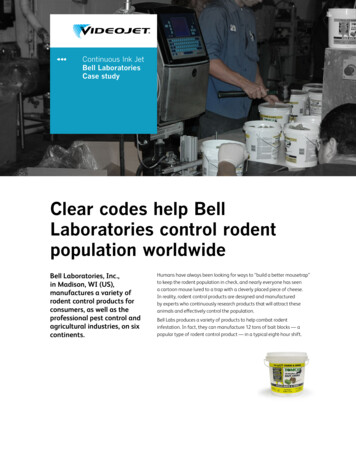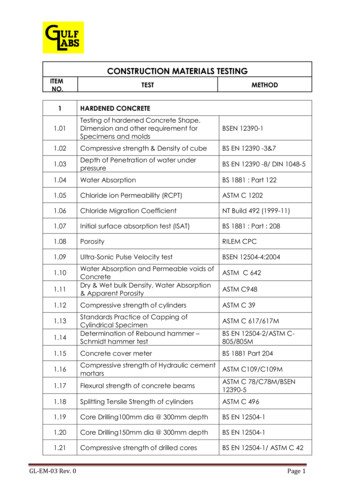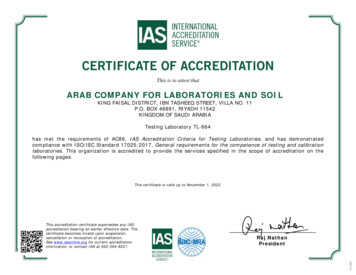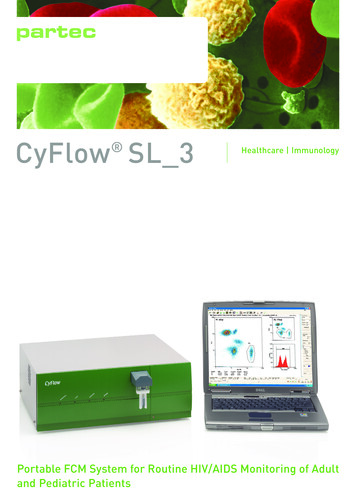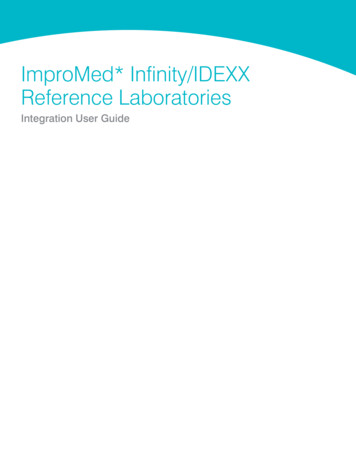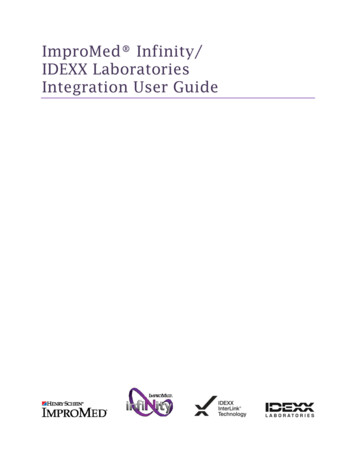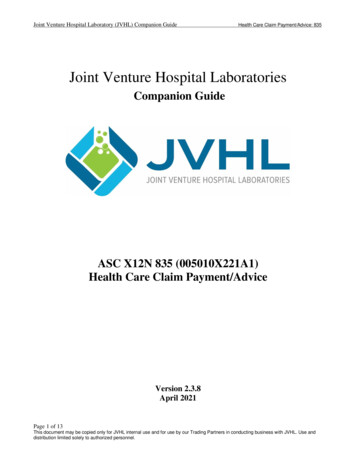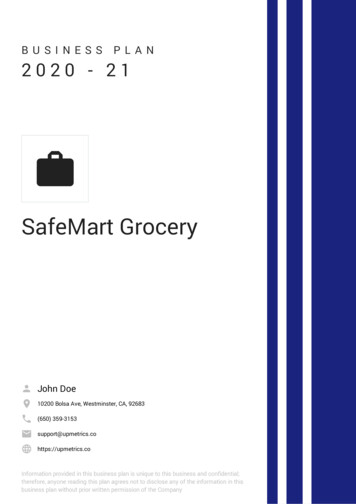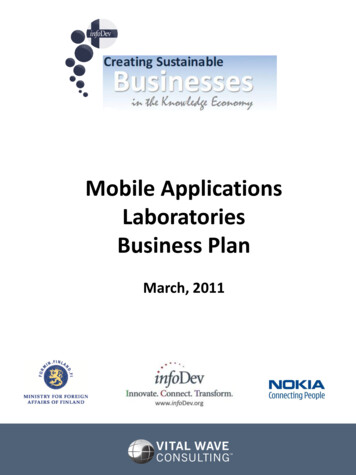
Transcription
Mobile ApplicationsLaboratoriesBusiness PlanMarch, 2011
ForewordIt is my pleasure to present the newly completed toolkit for regional mobile application laboratories(mLabs), which was funded by the Government of Finland. infoDev's efforts to drive mobileinnovation in emerging markets are aligned with our broader agenda of creating sustainable,inclusive growth by fostering competitiveness and promoting employment.This activity has been carried out as part of a joint Finland / infoDev / Nokia program on CreatingSustainable Businesses in the Knowledge Economy (see www.infodev.org/CSB). Initially, the primary usersof the toolkit will be the first five mLabs, located in Africa, Asia, and Eastern Europe and CentralAsia. However, the great interest in and demand for mLabs and similar initiatives from throughoutthe developing world imply that this toolkit will be beneficial to all those seeking to supportinnovation and entrepreneurship, in the ICT sector.There is no substitute for understanding local markets and designing feasible business models tomeet the needs of local clients and stakeholders. Business Plans have to be tailored to local needsand no two mLabs will follow the same template. Nevertheless, this toolkit provides a usefulbaseline that can accelerate the planning and establishment of successful and sustainable mLabs andis an analytical tool for those in the early stages of mLab planning. For example, the financialworkbook provides methods for necessary growth figure analysis using case study examples as aguide to achieve sustainability.infoDev is pleased to make available the mLab Business Plan, both as a resource and as a startingpoint for future collaboration. I look forward to the wide range of locally grown mobile applicationsand business synergies that will result from the establishment and continued sustainability of ourmLabs.Valerie D'CostaProgram Manager, infoDevCopyright 2011Page 1 Foreword
AcknowledgementsThe Mobile Application Laboratories Business Plan report was authored by Vital Wave Consultingbetween September 3, 2010 and December 13, 2010 under the supervision of infoDev with supportfrom The Ministry for Foreign Affairs of Finland and in partnership with Nokia.infoDev, The Ministry for Foreign Affairs of Finland, Nokia and Vital Wave Consulting would liketo thank everyone who has generously shared their insights and knowledge to inform this report.From the partner organizations, we thank the following individuals: The Ministry for Foreign Affairs ofFinland: Lindy Ilari; infoDev: Dr. Tim Kelly, Toni Eliasz, Maja Andjelkovik, Kevin Donovan andOltac Unsal; Nokia: Jussi Hinkkanen, Jussi Impiö, King'ori Gitahi and Teemu Kiijärvi.Vital Wave Consulting conducted 35 in-depth interviews with subject-matter experts, incubationlabs, entrepreneurs who have used incubation services and potential lab partners including NGOs,universities and multinational corporations.We are especially grateful to the following individuals for theirsubstantive contributions to the report: Annelee Le Grange, Bagrat Yengibaryan, Ben Zaaiman, BillZimmerman, Daniel Stern, Daniel Thalhammer, Eric Cantor, Jessica Colaco, Nathan Eagle, NealLesh, Sean Murphy, Sebastian Melin, Su Kuhumba and Wayan Vota.Copyright 2011Page 2 Acknowledgements
Table of ContentsList of Figures. 4Executive Summary . 5Introduction . 9Part 1: Landscape Analysis .11Part 2: Segmentation Analysis .19Part 3: Offerings and Promotional Strategies .28Part 4: Business Model and Pricing Strategies .42Part 5: Operating Model .50Part 6: Customer and Partner Profiles .53Appendix A - Service Level Value Chains .60Bibliography .65Copyright 2011Page 3 Table of Contents
List of FiguresFigure 1. Table of mLabs Stakeholders .10Figure 2. Distribution of Technology Incubation Programs.12Figure 3. Matrix of Services .18Figure 4. Lab Segmentation .20Figure 5. Segment Profiles .22Figure 6. Membership Categories .29Figure 7. The mLab Value Chain .31Figure 8. Example Scenario: mLab Service Offerings by Membership Category .32Figure 9. Overview of Content and Services Offered by mLabsWorld .41Figure 10. Framework to Evaluate Priority of Service Offerings .43Figure 11. Business Model Workbook Tool Overview.45Figure 12. Fundamental mLab Resource Requirements .50Figure 13. Key Players and areas of competence .51Figure 14. The mLab position in the mServices Value Chain .53Figure 15. The Development and Distribution Process .54Figure 16. Venture Funding Service Value Chain .60Figure 17. Business Training Service Value Chain .60Figure 18. Mentoring Service Value Chain .61Figure 19. Technical Training Service Value Chain .61Figure 20. Testing and Certification Service Value Chain .62Figure 21. Market Intelligence Service Value Chain .62Figure 22. Physical Space Service Value Chain .63Figure 23. Content and Distribution Service Value Chain .63Figure 24. Professional Services Service Value Chain .64Copyright 2011Page 4 List of Figures
Executive SummaryWorldwide, mobile phones are becoming the most widely available communcation platforms.Particularly in the developing world, where conventional telecom infrastructure is often lacking,operators are rapidly building out their wireless networks to reach potential mobile phone customerseven in the most rural areas.This brisk adoption of the mobile phone is being driven by the countless applications now availablethat allow users to communicate, access real-time data, and perform everyday transactions. But whocreates these applications? Surprisingly, it is not always the large mobile operators or globaltechnology companies that create many of these end-user services. Instead, these services are oftendeveloped by startups and entreprenuers, who bring a passion for innovation to solve the socialissues and address the market needs of their local areas through mobile technology.But passion is not always enough to get a new business off the ground. To succeed, theseentrepreneurs will need tangible resources like funding, training and important business connectionswith the entire ecosystem of market players in their area. They often find these resources in thebusiness incubation programs set up by local governments, development agencies, or multinationalcorporations.The concept of business incubation has existed for quite some time, and considerable literatureexists providing practical guidance on how to start, operate and maintain these programs. However,only recently have some programs started to focus specifically on mobile applications and services,so far less material exists to inform these programs. The purpose of this business plan is to help fillthat gap.Business Plan OverviewThis Mobile Application Laboratories Business Plan is sponsored by infoDev, a World Bank agency,working in cooperation with The Ministry of Foreign Affairs of Finland and Nokia. Specifically, thegoal of the plan is to inform infoDev-supported mobile application labs in Africa, Asia, and EasternEurope and Central Asia (ECA) – and other mobile application laboratory initiatives globally – todevelop sustainable business models and transition from a donor-funded start-up phase to a selffinancing, sustainable phase over a three-year period.The plan‟s six chapters cover the following topics: Landscape Analysis describes mobile applications labs and similar organizations,including success factors and challenges across these labs. Segmentation Analysis offers a typology of mLabs based on relevant definingcharacteristics and explores examples from parallel fields (e.g., software development,Copyright 2011Page 5 Executive Summary
business incubation, technology transfer) to identify the characteristics of labs thatfunction most effectively. Offering & Promotional Strategies examines the services that best supportsustainability for the mLab, and offers strategies for driving branding and awareness. Business Model and Pricing Strategies defines potential revenue streams for theservices that the labs offer, including potential price lists and menus of options that aretailored to regional markets via the companion Business Model Workbook Tool. Operating Model provides recommendations on resource requirements (e.g.,equipment, staffing, skills) and the phased rollout of services and functions over time. Customer and Partner Strategies including the identification of intermediate clients(e.g., mobile applications developers, SMEs), end clients (e.g., app stores, networkoperators, equipment manufacturers, governments) as well as potential partners,investors and donors.Key Findings from Business Plan Research and AnalysisIncubators that focus solely on the development of mobile application businesses are a relativelyrecent phenomenon. This means that there is a tremendous opportunity to develop mLabs, but atthe same time, information on the successful operation of these labs is scarce. This suggests thatmLab managers must remain flexible and adaptable to lessons learned in real time. There is no oneright model for operating these labs. Public or private organizations or a consortium of public andprivate entities working in partnership can be equally well suited. Most importantly, mLabs willrequire that stakeholders‟ incentives be aligned via a localized business model to ensure thatlaboratories will be successful in accelerating entrepreneurial growth.A broad spectrum of technology incubators exists throughout the developing and developed world.Socially oriented incubators occupy one end of this spectrum. They rely primarily on grants andcontributions to sustain operations and provide products and services that assist non-governmentalorganizations (NGOs) and local governments to deliver public services. On the other end of thisspectrum are private, profit-oriented incubators that seek entrepreneurs to develop applications forcommercial sale locally and internationally. mLabs that can combine aspects of both segments willenjoy the widest possible range of earned revenue opportunities. Also, this hybrid model aligns withthe aspirations of a majority of entrepreneurs who want to earn a profit while achieving positivesocial change.Entrepreneurs who develop mobile applications have a wide variety of needs, and so a tieredmembership scheme allows the lab to adopt service offerings for different end-user segments. Ingeneral, mLab users identify their greatest needs as startup capital and opportunities to network withmobile ecosystem players and other technology entrepreneurs. In addition, many mobile applicationCopyright 2011Page 6 Executive Summary
ent
Business Plan Overview This Mobile Application Laboratories Business Plan is sponsored by infoDev, a World Bank agency, working in cooperation with The Ministry of Foreign Affairs of Finland and Nokia. Specifically, the goal of the plan is to inform infoDev-supported mobile application labs in Africa, Asia, and Eastern Europe and Central Asia (ECA) – and other mobile application laboratory initiatives globally – toFile Size: 1MBPage Count: 66
